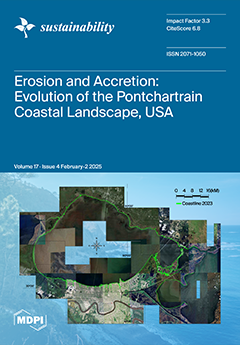Over the past decade, China’s air quality has improved significantly. To further mitigate the concentration levels of fine particulate matter (PM
2.5), this study analyzed the spatio-temporal evolution of PM
2.5 concentrations from 2012 to 2022. Furthermore, the study integrated the generalized
[...] Read more.
Over the past decade, China’s air quality has improved significantly. To further mitigate the concentration levels of fine particulate matter (PM
2.5), this study analyzed the spatio-temporal evolution of PM
2.5 concentrations from 2012 to 2022. Furthermore, the study integrated the generalized additive model (GAM) and GeoDetector to investigate the main driving factors and explored the complex response relationships between these factors and PM
2.5 concentrations. The results showed the following: (1) The annual average concentration of PM
2.5 in China peaked in 2013. The annual reductions of PM
2.5 in each city ranged from 1.48 to 7.33 μg/m
3. In each year, the PM
2.5 concentrations were always consistently higher in north and east China and lowest in northeast and southwest China. (2) In terms of spatial distribution, the North China Plain, the Middle and Lower Yangtze River Plain, and the Sichuan Basin exhibited the highest PM
2.5 concentration levels and showed high aggregation characteristics. (3) The GeoDetector analysis identified the concentrations of SO
2, NO
2, and CO and the meteorological conditions as important factors influencing the spatial differentiation of PM
2.5. The results of the GAM showed that the meteorological factors, such as temperature, atmospheric pressure, wind speed, and precipitation, generally had specific inflection points in their effects on the PM
2.5 concentration levels. The relationship of PM
2.5 with the gross domestic product and population density followed an inverted U shape. The PM
2.5 concentrations under the land use types of cropland, barren, impervious, and water were higher than others. The concentration of PM
2.5 decreased significantly under all land use types. Our work can be used as a strong basis for providing insights crucial for developing long-term pollution control strategies and promoting environmental sustainability.
Full article





